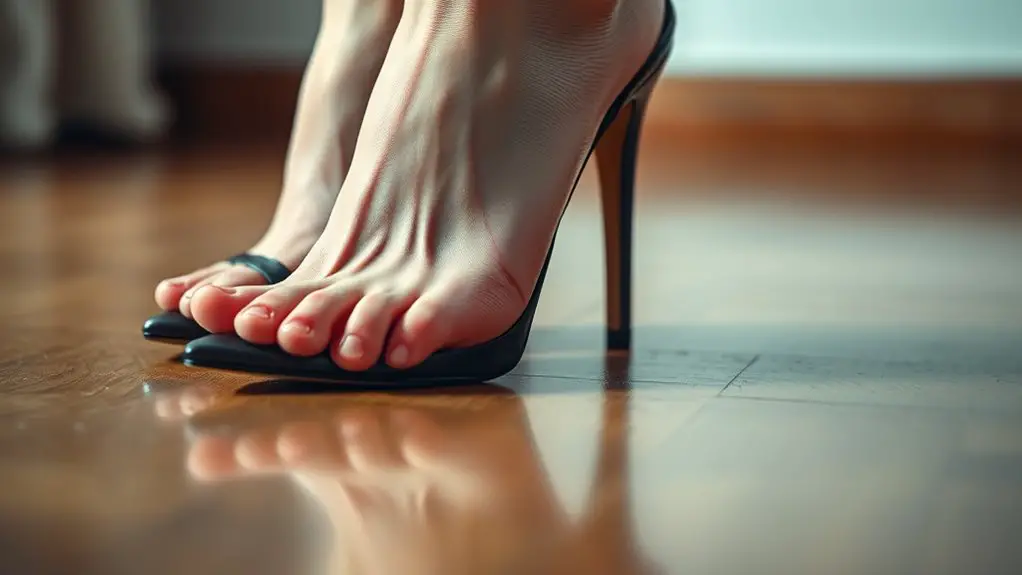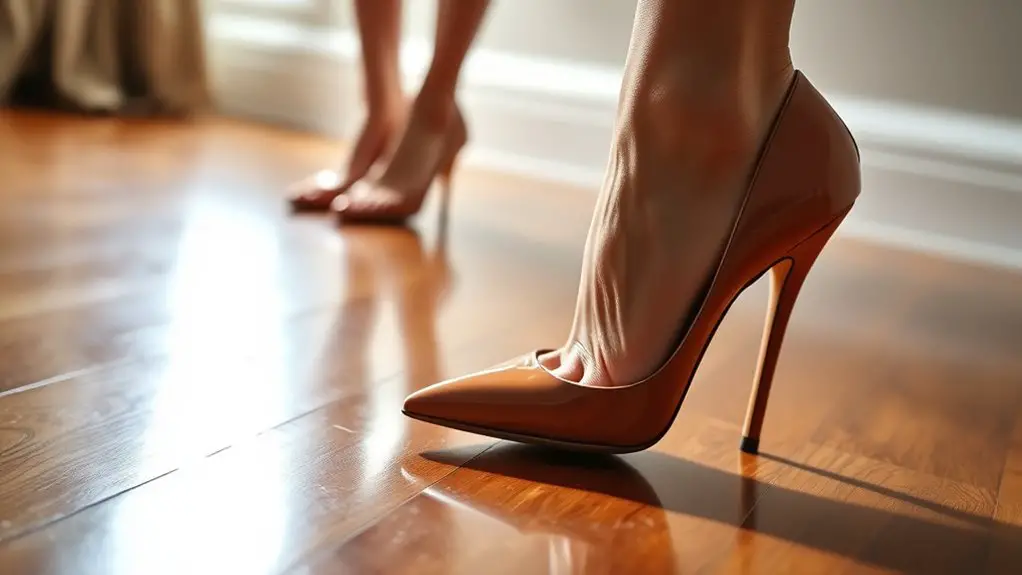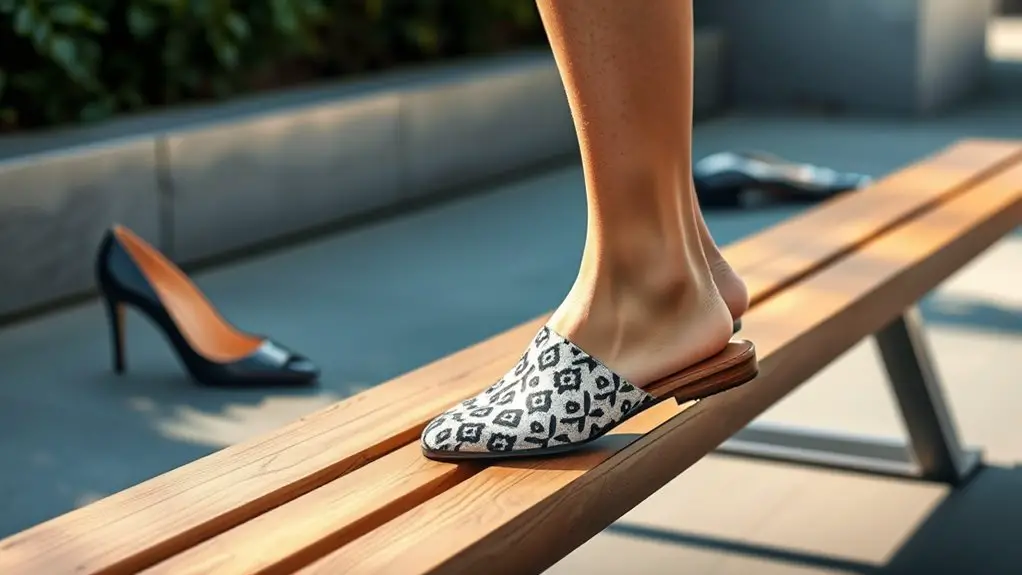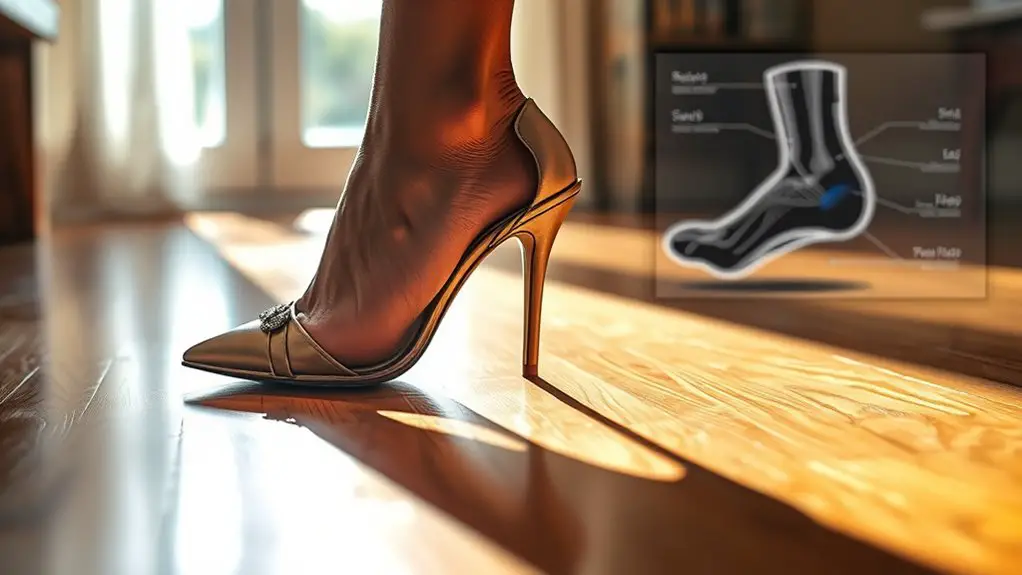Yes, wearing high heels can indeed cause long-term foot problems. The unnatural posture and pressure exerted on your feet lead to issues like bunions, plantar fasciitis, and hammertoes. As weight shifts forward, stress on the forefoot increases, resulting in pain. Lack of arch support compounds discomfort and may contribute to improper alignment. For a better understanding of how heel height impacts foot health, take a look at the following details.
Understanding the Anatomy of the Foot

The foot is a complex structure comprised of 26 bones, 33 joints, and numerous muscles, tendons, and ligaments. This intricate anatomy plays a significant role in supporting your body weight, facilitating movement, and absorbing shock. When examining the foot structure, you’ll notice that the bones are categorized into three groups: the hindfoot, midfoot, and forefoot. Proper bone alignment is essential for maintaining balance and preventing injury. Each joint allows for a range of motion, enabling activities such as walking, running, and jumping. Ligaments connect bones, providing stability, while tendons attach muscles to bones, facilitating movement. Understanding this anatomy can help you appreciate how footwear choices, particularly high heels, impact your foot health. Misalignment due to improper footwear can lead to discomfort and long-term issues, emphasizing the importance of choosing shoes that support the natural foot structure.
Common Foot Problems Associated With High Heels
While high heels may enhance your appearance, they can also lead to a variety of foot problems. One common issue is bunion formation, which occurs due to the pressure high heels place on the toes, causing misalignment. Additionally, wearing heels increases the risk of plantar fasciitis, a painful condition affecting the tissue that connects your heel to your toes.
Here’s a brief overview of foot problems associated with high heels:
| Foot Problem | Description |
|---|---|
| Bunions Formation | Bony bumps at the base of the big toe. |
| Plantar Fasciitis Risk | Inflammation of the tissue on the bottom of the foot. |
| Hammertoes | Deformity causing toes to bend downward. |
| Metatarsalgia | Pain in the ball of the foot. |
| Ankle Sprains | Injury from instability due to heel height. |
Understanding these risks can help you make informed decisions about your footwear.
The Science Behind Heel Height and Foot Health

Understanding how heel height affects foot health is crucial, as even slight variations can lead to considerable changes in pressure distribution and biomechanics. When you wear heels, your body weight shifts forward, altering your natural posture. This shift can adversely affect heel biomechanics, increasing stress on the forefoot and potentially leading to issues like metatarsalgia or plantar fasciitis.
High heels often lack adequate arch support, which exacerbates the imbalance and contributes to foot discomfort. Insufficient arch support can lead to overpronation or supination, further complicating your foot health. Additionally, the higher the heel, the more pronounced these effects become, as your body compensates for the unnatural angle.
It’s essential to be aware of these factors when selecting footwear, as your choice can greatly impact not only your immediate comfort but also your long-term foot health.
Tips for Wearing Heels Comfortably and Safely
Choosing the right heels is essential for maintaining comfort and minimizing potential foot issues. First, look for shoes with adequate heel cushioning to absorb impact and reduce stress on your feet. This cushioning can help prevent discomfort, especially during prolonged wear.
Next, consider the design of the shoe and its impact on your foot arch. Opt for heels that provide support and don’t excessively elevate your foot, as this can strain your arch over time. Shoes with a wider toe box can also help reduce pressure on your toes, enhancing overall comfort.
Additionally, try to alternate between heels and more supportive footwear throughout the week to give your feet a break. Finally, when possible, limit the duration of heel wear and incorporate stretching exercises for your feet to maintain flexibility and strength. Following these tips can greatly improve your experience while wearing heels, ensuring you prioritize both style and foot health.
Alternatives to High Heels for Fashionable Footwear

If you’re seeking stylish alternatives to high heels, there are numerous options that blend fashion with foot health. Choosing the right footwear can maintain your style without sacrificing comfort. Consider these alternatives:
- Fashionable Flats: These provide elegance without the discomfort of heels. Look for styles with arch support and cushioned insoles to guarantee all-day wearability.
- Chic Sneakers: Sneakers have evolved into fashionable staples. Opt for sleek designs that can complement various outfits, from casual to semi-formal, while offering essential foot support.
- Block Heels: If you still crave a little height, block heels distribute weight evenly, reducing pressure on your feet compared to stilettos.
Frequently Asked Questions
Can Wearing Heels Affect My Posture Long-Term?
Wearing heels, particularly with significant heel height, can subtly alter your posture alignment over time. You might not notice it initially, but long-term use can lead to imbalances affecting your spine and overall posture.
Are Certain Heel Styles Safer Than Others?
Certain heel styles offer varying safety levels. Platform heels provide stability, while wedge heels enhance balance. Block heels offer comfort for prolonged wear, and kitten heels allow flexibility, reducing strain on your feet during use.
How Do Heels Impact Athletic Performance?
While you might think heels enhance elegance, their heel biomechanics can hinder athletic performance. Elevated heels alter alignment, negatively impacting performance metrics like speed and agility, ultimately compromising your overall effectiveness in physical activities.
Can Heel Height Influence My Overall Leg Strength?
Heel height can considerably influence your overall leg strength by altering heel biomechanics and muscle engagement. Higher heels may engage different muscle groups, potentially leading to imbalances or weaknesses over time, impacting your overall strength.
What Is the Best Way to Transition to Flats?
Moving to flats can be a gentle journey. Gradually introduce heel alternatives and incorporate foot exercises to strengthen muscles. This way, you’ll ease into comfort while ensuring your feet adapt naturally to the shift.



